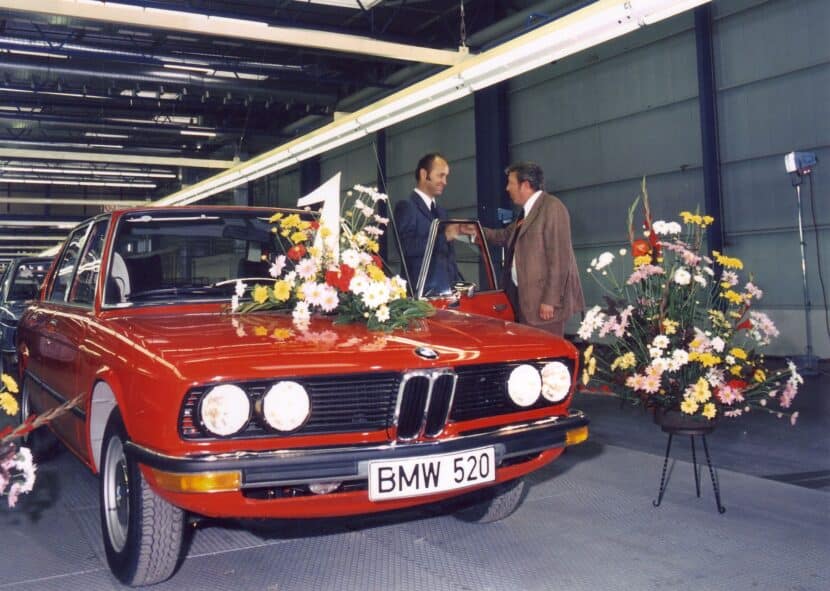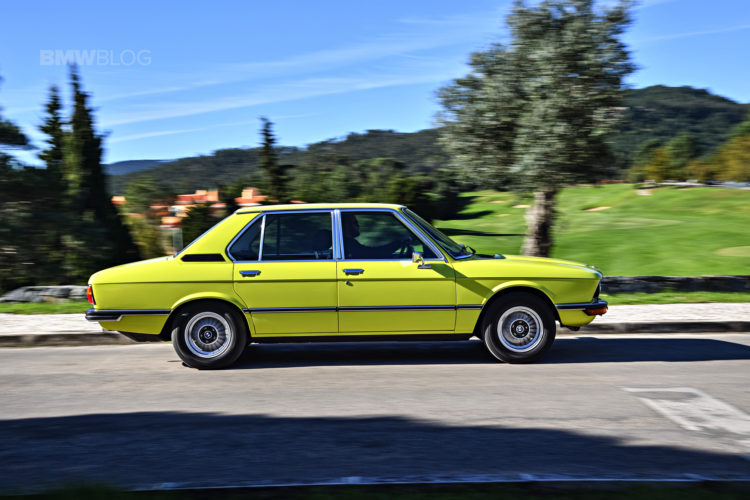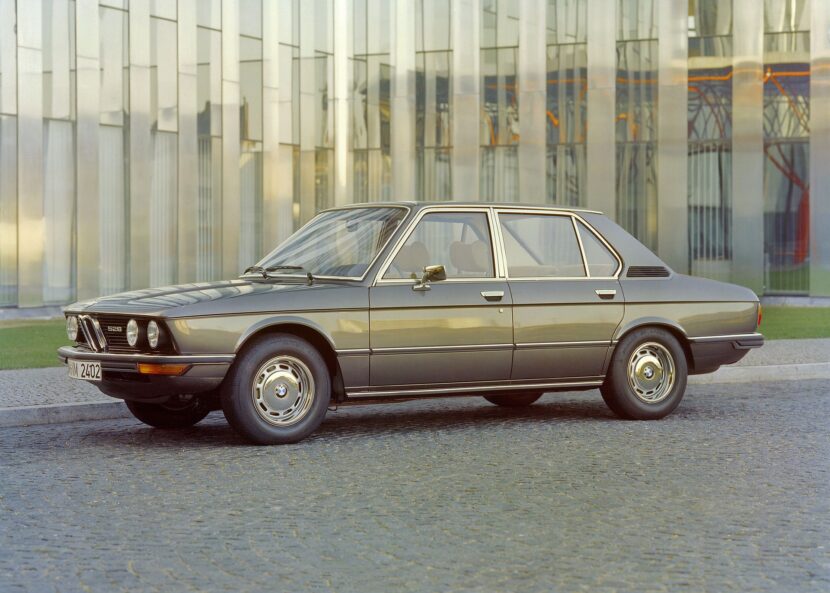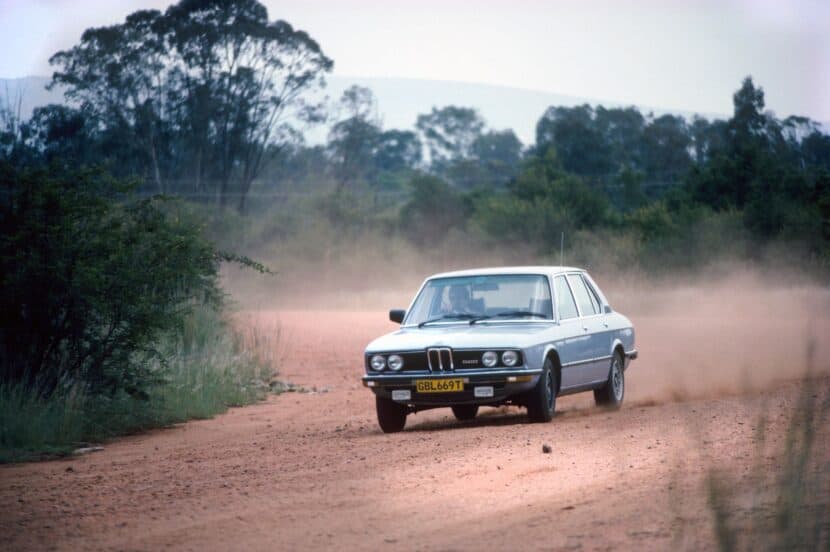As another 5 Series enters production, we look back at the original E12 generation. I have to admit that I haven’t been to any launch events for the new G60 BMW 5 Series. I didn’t go to any for for the previous model either but I did organize one for the F10. Was that really almost fourteen years ago? I remember E28s well as new cars and went to an E34 5 Series dealer launch. Yeah, I’m getting on in years.
1972 – The BMW 520

The E12 BMW 520 might have looked like a new model, but in fact, it used a lot of parts from existing models, namely the E3 2500 saloons for suspension and final drive parts, and the Neue Klasse models that it replaced for transmissions. Little was exactly as before, but a BMW mechanic would recognize most of it instantly. The BMW 520 was built initially at Munich, but production had moved to the newly minted Dingolfing plant by 1973, and fifty years later, the eighth-generation cars would also roll from the same factory gates.
The 520 used the venerable (even then!) M10 iron block alloy head SOHC four-cylinder that was now ten years old. Now, though, the piston crown and cylinder head design had been revised with the familiar E12 casting moniker on the inlet manifold side, plus it had a very unusual carburetor setup – a pair of Zenith Stromberg 175CDET carburetors. Why this arrangement was used in preference to the usual twin-choke single Weber or Solex as used on the 2002 or later 320 is unclear, but even so, the 520 motors gave 115 bhp compared to the outgoing BMW 2000, thanks to two carburetors and a higher compression ratio.
At 182 inches long, it was comparable to the Volvo 144, Audi 100, and the new Alfetta, plus at 1230 kg it was 100 kg heavier than the old 2000, so it needed those extra 15 ponies. Tires were 175 SR14 radials. A heated backlight, cloth trim, and laminated windshield were standard. From late 1975, a revised ‘E21’ engine was fitted, and the tachometer was often replaced by a large clock. Performance was adequate, as road tests used to say.
0 to 60 mph took 11.3 seconds with an 18-second quarter mile and 109 mph all out. The gearbox was the Getrag 242 four-speed, a new unit with excellent synchromesh, and the final drive was an E3 ‘side loader’ unit but with a new ratio of 4.1:1 – a long-legged cruiser it was certainly not. But, more was to come.
Faster – The BMW 520i
Coming very shortly after in early ’73 was the fuel injection model. The revised E12 version M10 was given the Kugelfischer fuel injection system from the previous 2000 Tii, and this engine also went into the 2002Tii from late 1972. With a higher compression again (9.5 rather than 9.0), the 520i had a useful 130 bhp. That resulted in a 10.5-second 0-60 sprint, a 17.5-second quarter, and 116 mph.
That’s not the whole story though because the 520i also used a taller final drive of 3.9:1 that gave the injection car longer legs and a far more relaxed feel on the road. This new vigor was enhanced in other ways too – HR-rated tires and a slightly larger front sway bar, 22 mm rather than 21 mm. The 520i was the first E12 to have the model designation on the front grille. In 1975, the 520i was given the revised E21 engine like the 520i – another revision to the pistons and cylinder head and the Bosch K Jetronic CIS fuel injection system. The 520i would be discontinued in 1977 – for now.
1973 – The BMW 525
With 520 productions now in full flow at Dingolfing, late 1973 saw the first six-cylinder Five, the 525. BMW created this by basically fitting the 2494 cc M30 six-cylinder engine, Getrag 262 gearbox, and 3.64 ratio final drive from the E3 2500 into a 520 shell. The engine was nominally 150 bhp in the 2500 but was now rated at 145 bhp in the 525. Stronger springs and dampers were used as well as the 520i sway bars and HR-rated tires and rear disc brakes.
Carburation was twin Solex 35/40 double-choke carburetors with a 9:1 compression ratio. The hood was also given a raised power bulge to clear the larger air cleaner. This 2500 engines would seem fairly lazy – the 117 mph top speed and 0-60 time of 10.6 seconds appear little different from the 520i… ditto the 17.8-second quarter. But even with the taller final drive ratio, the 525 could not quite hit sixty in the second gear (58 mph) so it was actually faster in reality and was far nicer and more relaxed to drive. Power steering was standard from October ’75.
1974 – The BMW 528
Now we’re talking. When the 200 bhp E3 3.0Si arrived in late 1971, the regular 180 bhp 3.0S became automatic only and there was a gap in the BMW range for a car like the 528. Taking the 525 as a basis, the 528 added vented disc brakes, slightly stiffer suspension (but not by much), 195/70×14 tires plus of course the 170 bhp engine from the 2800 saloon allied to the 3.64 final drive. Now, the E12 was a brisk car. 0 – 60 took nine seconds, the standing quarter 16.9 seconds, and 122 mph was the all-out maximum. Power steering was fitted, and you could order a Borg Warner Model 65 automatic that frankly spoiled the car. The later ZF versions were better but really, you needed the four-speed manual.
…..And The BMW 518!
In 1974, the 2002 Turbo and E9 CSL had gone and a fuel crisis was biting hard. What better time then to introduce an economy model? The 518 was created by taking a base model 520 and fitting the 1766 cc engine from the 1802 with a single-choke Solex carburetor. Even fitting a very low 4.44 ratio final drive couldn’t save the 518 from being desperately slow so in July 1975, the revised E21 engine with a double-choke Solex carb was fitted. With 90 bhp the 518 was still no ball of fire requiring 5000 rpm to do 80 mph but was at least quite decent around town. It was also no more economical than a 520. It would find a loyal customer base of retired folk and taxi operators.
1975 – The US BMW 530i
You can thank EPA rules for this one. They weren’t going to allow U.S. buyers to have a lively and economical 528, so the 530i was cobbled together. A 3.0 engine as used to try and claw back some power after the dreaded thermal reactors were fitted. These were basically crude early catalytic converters, manifolds that ran super hot thanks to retarded ignition timing. A weird fuel injection system was used to deliver a fuel mixture rich enough to prevent the poor engine from detonating and really, the whole thing was a disaster. Power was 176 bhp and economy 19 mpg, so worse than the 528. California market cars were even worse with some owners claiming just 12 mpg. For 1976, the 530i was given the L Jetronic 630i engine and in 1978 it was gone, replaced by a Federal 528i.
1976 – The Facelift
By late 1976 the E12 had been around for four years and the Mercedes W123 – as redoubtable a car as any Daimler Benz was back then – had been launched. BMW revised the E12 with larger taillights, the fuel filler relocated from the rear panel to the rear quarter, and a new hood with a raised center section and a taller front grille kidney. The 525 and 528 were given new carburation – the twin 35/40 INAT Solexes were replaced by the new four-barrel Solex 4A1, later nicknamed the Four-Headed Monster due to its astonishing complexity compared to a Holley or Rochester Quadrajet plus the difficulties with maintenance – a truly ghastly device. All E12 cars were given extra facia air vents, a new steering wheel, an electric driver’s door mirror, and a new sunroof that tilted as well as sliding.
1977 – The 528i and Transformation
The Solex 4A1 carburetor had given the 528 very little more performance but inferior fuel economy, so it was time for a serious rethink. To fix it, Bosch L Jetronic fuel injection from the 633CSi and 733i was fitted, and the result was a boost from 170 to 177 bhp. Not much on paper but in reality, it was a different car. The 528i was also given a taller 3.45 final drive and that enabled sixty to be achieved in second gear in 8.7 seconds. The quarter took 16.8 seconds at 83 mph and the top speed was an impressive 131 mph….now we’re cooking! Optional Bilstein suspension and a limited-slip differential were common options for the serious pilot. 1977 also saw the introduction of E23 7 Series steel wheels and a steering wheel while the trunk lid badges lost the black backing. The famous ‘Automatic’ badge was also discontinued.
…….Plus A New 520
At the same time, the M10 520 and 520i were discontinued and replaced by a new six-cylinder 520 with no injection version. This all-new engine was initially coded M60 but was later renamed the M20 in late 1982 with the E28 and original E30. The new M60 was a familiar kind of BMW engine – iron block, alloy head, SOHC, two rocker shafts, and inclined valves. But now, the camshaft was driven by a toothed rubber belt, one of only two BMW engines to use this idea (the 87-93 M40 was the other). With a Solex 4A1 four-barrel carb, the 520/6 gave 122 bhp and it was certainly a smooth and characterful engine, but it was heavy on fuel and had problems in service, namely that damned carburetor and often a cracked cylinder head. The 3.91 final drive was used, and it was a very pleasant car to drive.
1980 – The M535i
BMW had been building hot 5 Series for special customers since 1973, dropping complete CSL engines and transmissions into 525’s, etc., but the M535i was the first proper commercial version. Starting with a 528i, BMW Motorsport simply fitted the mechanical parts from the original ‘full fat’ Euro 635CSi. This started with the 3453 cc L Jetronic M90 engine with 218 bhp and to this was bolted the Getrag 265 close ratio gearbox with a direct top gear (not overdrive) and first gear to the left and back.
A 3.07 ratio limited-slip diff was fitted complete with oil cooler/reservoir along with Bilstein suspension and fat sway bars. 195/70 VR14 tires were used, and for 1980 the performance was startling – 140 mph, 0-60 in seven seconds, and 0-100 in 19.2 secs….that is still pretty good today. A 15.7 standing quarter reinforced these Porsche and Ferrari baiting figures…okay, not a Turbo or a Boxer, but your regular 911, 928, and 308GTB drivers look out!
1981 – The End
German E12 production ended in 1981 to make way for the E28, but the E12 carried on in South Africa until 1984. Upgraded with the E28 interior, the E12 was still a good car if looking increasingly ancient – by the time production ended, cars like the 190E Mercedes were here.










































































